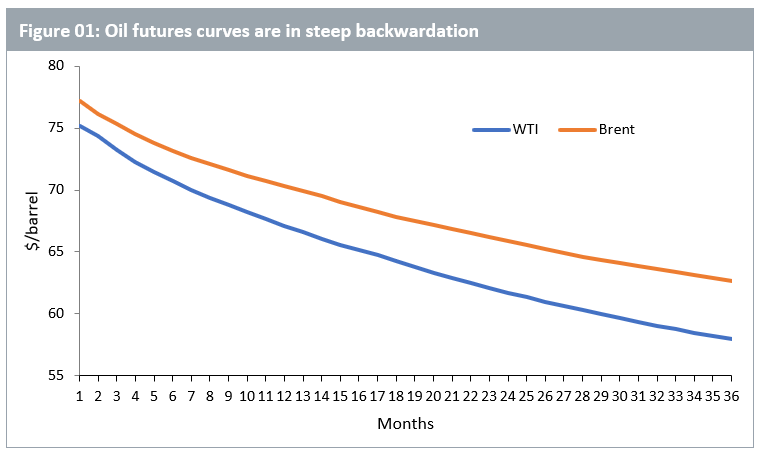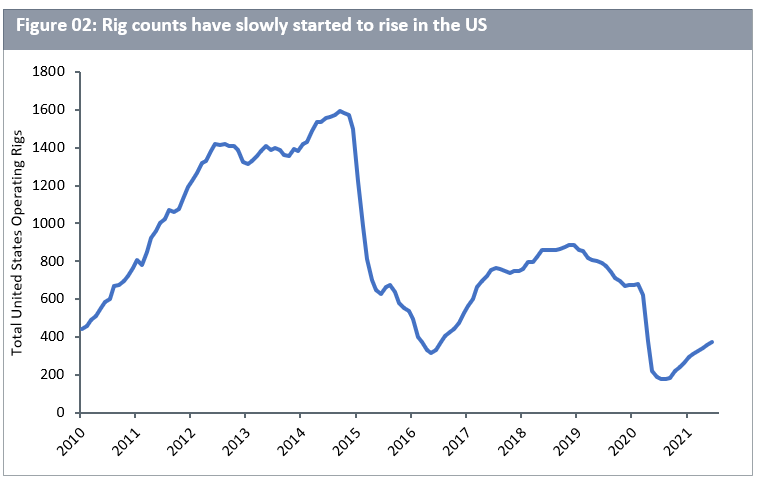Oil prices have hit a three-year high following a meeting of the Organization of the Petroleum Exporting Countries and its partners (OPEC+), the group was unable to agree on additional supply increases. Before the meeting had a delayed, yet inconclusive, end on Monday 05 July, markets had been pricing in a supply increase of 2 million barrels per day (mb/d) in increments of 400,000 b/d between August and December. The group had cut production by 10mb/d last year and current cuts stand at around 6mb/d relative to pre-pandemic levels. With United Arab Emirates (UAE) objecting to the baseline its cuts are calculated from (which effectively means it feels like it is cutting too much), the Gulf member of the cartel objected to some of the technical aspects of the deal. Its stand-off against Saudi Arabia and Russia – two OPEC+ heavyweights – led to a no-deal conclusion. This means that, as things stand, there will be no further supply increases after July until the end of April 2022. That is, the 2 mb/d of extra oil expected by the market will no longer come unless a new deal is struck. Moreover, discord among the group has raised question marks regarding the harmony within the group, something that has been pivotal in lifting oil markets over the last year.
So, are oil prices headed towards $100/barrel? It appears that OPEC+ holds the cards given demand is on the rise and US Shale industry has its own challenges to overcome. But a lot depends on how united the group can remain in its policy response as prices continue to rise.
When was Oil Last at $100?
Oil has staged an undeniable rally since November last year and predictions of prices breaching $100/barrel, an unfathomable state of the world one year ago, are garnering attention. Putting this in the context of recent history, oil prices have not been above $100/barrel since the third quarter of 2014. Back then, prices experienced significant weakness in the subsequent twelve months as Brent sank below $40/barrel by the end of 20151 due to a combination of tepid global economic growth and a supply glut from US Shale producers.
Global economic growth stands on much firmer ground today with the International Monetary Fund forecasting global growth at 6% in 2021 before moderating to 4.4% in 20222. With pent up demand from consumers and businesses expected to lift the global economy out of its recent slump, and infrastructure spend from governments around the world poised to provide much-needed support, oil demand is expected to grow as well. Oil futures curves remain in sharp backwardation indicating tightness in the oil market (see figure below).

Source: WisdomTree, Bloomberg. Latest closing prices of Brent futures are as of 05/07/2021 while the latest closing prices of WTI futures are as of 02/07/2021.
The Structural Challenges for US Shale
Oil bulls tend to point towards a potential structural decline in US Shale going forward. While US oil rigs are starting to come back online after a notable decline last year, the process has been relatively slow (see figure 02 below).

Source: WisdomTree, Bloomberg. Data as of 30 June 2021.
Erik Gilje, Professor of Finance at University of Pennsylvania’s Wharton School of Business, asserts that even though rig counts have risen slightly in recent weeks, pre-pandemic levels of output are unlikely to be restored given there can be 15-20% impairment when bringing rigs back online. Additional investment is required to bring US supply back to pre-pandemic levels but securing this investment is challenging for multiple reasons.
First, investors who have not received dividends from US Shale producers in the last decade are now imposing a more stringent cost for their capital. They are not only demanding capital expenditure by the producers but want them to also be cash flow positive. Investors seeking carbon neutrality are also posing more challenging questions to oil producers which further raises their cost of capital.
Second, capital expenditure is on the decline as companies have become more cautious with their spending in recent times. According to Rystad Energy, total capital expenditure in US Shale dropped by more than half year on year in 2020. Whether this can be restored remains a question mark.
Third, President Biden is also attempting to strike a balance between imposing tighter environmental policies without decimating the oil industry. His recent veto of the Keystone XL pipeline that was designed to bring oil from Canada’s Alberta province to Nebraska 1200 miles south is a sign of headwinds in the way of building pipeline infrastructure. While pipelines may be cleaner than transporting oil through other means, they are built to last for 40-50 years – a timeframe Biden’s government may not be envisioning for the oil industry.
The energy transition is ultimately expected to cause the demand for oil to wane but underinvestment too soon, before the world has secured sufficient alternative sources of energy, could create a deficit. This could send oil prices soaring, as oil bulls would argue. And while the Energy Survey of the Federal Reserve Bank of Kansas City points to a slight increase in capital expenditure recently, the magnitude may not be large enough to plug the potentially widening gap.
OPEC+ Holds the Cards
The International Energy Agency foresees demand returning to pre-pandemic levels by the end of 2022, rising 5.4 million barrels per day (mb/d) in 2021 and a further 3.1mb/d next year. With US production expected to increase by 1.6 mb/d this year, OPEC+ has enough room to increase supply by 1.4mb/d above its July 2021-March 2022 target. And despite raising oil production by 2mb/d over the May-July period, OPEC+ will have 6.9mb/d of spare supply capacity. Furthermore, if sanctions on Iran are lifted, another 1.4mb/d may flow towards the market3.
This means that in the near-term, there is ample supply that OPEC+ can release to balance the market. Oil bulls may postulate that OPEC+ may not be in a rush to open the taps as the idea of US Shale producers capturing more market share may not cause OPEC+ the same degree of angst going forward as it has over the last decade. But there are three reasons for OPEC+ to not let oil prices run too hot. First, dissenting voices within the union may become louder given harmony within the group is not a given – last year’s price war between Russia and Saudi Arabia has not faded from the short-term memory yet, and UAE’s angst over its share of supply signals how perilous the union can be. Second, if prices are allowed to run too high, this could further incentivise US Shale producers to deploy capital expenditure. And third, fiscal breakevens have already been achieved for the largest producers at current price levels (fiscal breakeven for Saudi Arabia is $76.2/barrel4).
Moreover, Saudi Arabia has also indicated that it intends to increase its production capacity to 13mb/d, up from 12mb/d currently – perhaps something the Kingdom has been triggered to consider following last year’s price war with Russia. This is another potential sign that Saudi Arabia may not want to keep production too low for too long. Indeed, the driver behind UAE’s angst is that it has invested heavily in production expansion and is itching to use it.
Admittedly, between current price levels and $100/barrel (and beyond), there is ample room for oil prices to rise further. The point at which prices ultimately get capped is likely to be determined by how high a price OPEC+ are comfortable with. The trajectory of prices in the interim will probably be determined by how quickly the group responds to increases in demand to balance the market. For now, the group has not announced when it will meet again sending oil prices on the charge.
Sources
1. Bloomberg
2. International Monetary Fund’s World Economic Outlook April 2021
3. International Energy Agency Oil Market Report June 2021
4. International Monetary Fund

